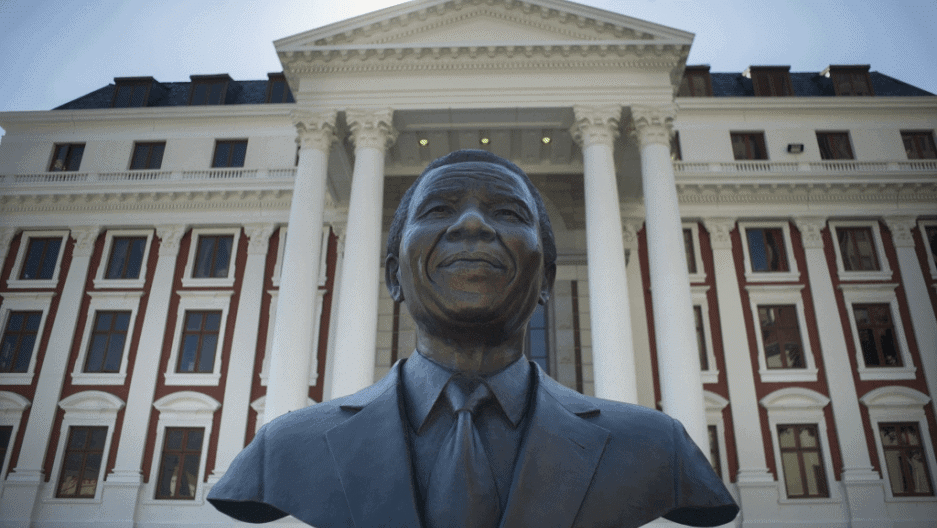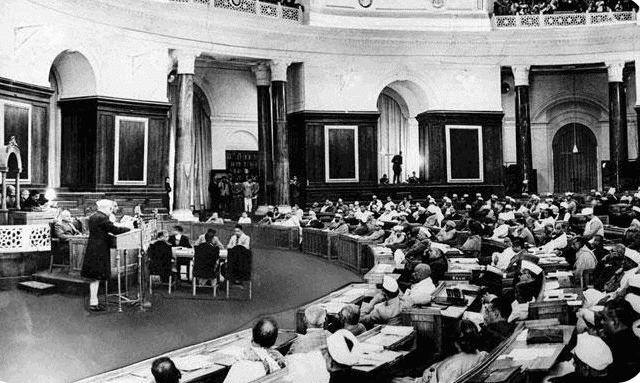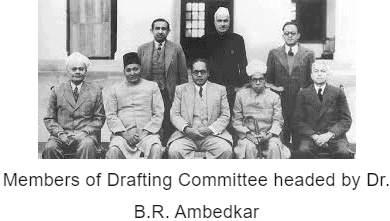Class 9 Exam > Class 9 Notes > Civics for Class 9 > Key Concepts - Constitutional Design
Key Concepts - Constitutional Design | Civics for Class 9 PDF Download
| Table of contents |

|
| Democratic Constitution in South Africa |

|
| Why do we need a Constitution? |

|
| Making of the Indian Constitution |

|
| The Guiding Values of the Indian Constitution |

|
Democratic Constitution in South Africa
- Nelson Mandela, the South African leader of the African National Congress, fought a long battle against Apartheid.
 A Statue of Nelson Mandela pictured outside the Parliament
A Statue of Nelson Mandela pictured outside the Parliament- Imprisoned for 28 years (1964–1992) emerged as the First President of the Republic of South Africa.
- People struggled against the horrible discrimination practiced against them by the white minority rulers.
- Apartheid finally defeated in 1994 and a new constitution made in 1996.
- The remarkable constitution, forgot past sufferings, sought the co-operation of all the races which make S. Africa based on equality, democratic values, and social justice.
Why do we need a Constitution?
- Yes. A constitution has written laws accepted by people living together in a country.
- It generates trust and coordination.
- It specifies how a government should be constituted.
- It lays down limits on the powers of the government.
- It expresses the aspirations of the people about creating a good society.
Question for Key Concepts - Constitutional DesignTry yourself: Why is a constitution important in a country?View Solution
Making of the Indian Constitution
- The process began during the national struggle for freedom.
- First draft 1928, then 1931. Motilal Nehru and 8 leaders demanded in the draft: universal adult franchise, social justice, right to freedom, and liberty.
- Participation in Provincial Legislatures helped Indians in framing their constitution.
- Leaders inspired by the French Revolution, the British parliamentary system, and the Bill of Rights of the US.
- They also learned what the British were denying Indian citizens.
 First Constituent Assembly of India
First Constituent Assembly of India
The Constituent Assembly
- Elections to the Constituent Assembly held in July 1946.
- Dr. B.R. Ambedkar appointed chairman of the drafting committee.

- Constitution adopted on 26 November 1949, and enacted on 26 January 1950, when India became a republic.
- The Constitution reflects the best minds of the country. Its members represented mini-India. Every law was debated clause by clause and a consensus arrived at.
- It is the longest written constitution.
The Guiding Values of the Indian Constitution
- Mahatma Gandhi was not a member of the Constituent Assembly, there were many members who followed his vision.
- Writing in his magazine Young India in 1931, Gandhiji had spelt out what he wanted the Constitution to do. He visualised a country, where all communities should live in perfect harmony. India will be free from the curse of untouchability, intoxicating drinks and drugs. Men and women will enjoy the same rights.
- BR Ambedkar played a key role in the making of the Constitution but he differed with Gandhiji on how inequalities should be removed. He often bitterly criticised Mahatma Gandhi and his vision.
Question for Key Concepts - Constitutional DesignTry yourself:Who was not a member of the Constituent Assembly?
View Solution
Philosophy of the Constitution
- The values that inspired and guided the freedom struggle formed the foundation for India's democracy.
- These values are embedded in the Preamble of the Indian Constitution.
- They guide all the articles of the Indian Constitution. The Constitution begins with a short statement of its basic values. This is called the Preamble to the Constitution.
- Most countries in the contemporary world have chosen to begin their Constitutions with a Preamble like American Constitution.
- The Preamble of the Constitution contains the philosophy on which the entire Constitution has been built. It is the soul of the Indian Constitution.
- The Preamble of the Constitution of India reads like a poem on democracy.
- It provides a standard to examine and evaluate any law and action of the government.
- The Preamble of the Indian Constitution.
The document Key Concepts - Constitutional Design | Civics for Class 9 is a part of the Class 9 Course Civics for Class 9.
All you need of Class 9 at this link: Class 9
|
17 videos|89 docs|30 tests
|
FAQs on Key Concepts - Constitutional Design - Civics for Class 9
| 1. Why is a democratic Constitution necessary in South Africa? |  |
Ans. A democratic Constitution is necessary in South Africa to ensure that the rights and freedoms of all citizens are protected and upheld. It provides a framework for the government to operate within, ensuring that it does not abuse its power and that it is accountable to the people. The Constitution also provides a mechanism for resolving disputes and conflicts within society, promoting peace and stability.
| 2. How was the Indian Constitution made? |  |
Ans. The Indian Constitution was made by a Constituent Assembly that was elected by the provincial assemblies. The Assembly met for the first time in 1946, and it took nearly three years to draft the Constitution. The drafting process involved extensive debates and discussions, with members of the Assembly representing a wide range of political, social, and religious perspectives. The Constitution was finally adopted on January 26, 1950.
| 3. What are the guiding values of the Indian Constitution? |  |
Ans. The guiding values of the Indian Constitution include democracy, socialism, secularism, and the rule of law. The Constitution enshrines these values in its preamble, which states that India is a sovereign, socialist, secular, democratic republic. These values are reflected in the various provisions of the Constitution, which establish a system of government that is accountable to the people, promotes social justice, and upholds the rights and freedoms of all citizens.
| 4. What are some key concepts of constitutional design? |  |
Ans. Some key concepts of constitutional design include federalism, separation of powers, and checks and balances. Federalism refers to the division of power between the central government and the state governments. Separation of powers refers to the division of power among the three branches of government: the legislative, executive, and judicial branches. Checks and balances refer to the system of checks and balances that ensures that no one branch of government becomes too powerful and that each branch holds the others accountable.
| 5. Why is it important to understand constitutional design? |  |
Ans. It is important to understand constitutional design because it provides the framework for how a government operates. A well-designed constitution ensures that power is distributed in a way that promotes accountability, promotes justice, and upholds the rights and freedoms of citizens. It also provides a mechanism for resolving disputes and conflicts within society, promoting stability and peace. Understanding constitutional design is therefore crucial for ensuring that a government operates in a fair, just, and effective manner.
Related Searches





















